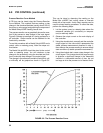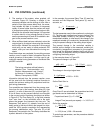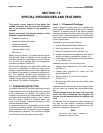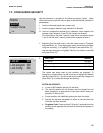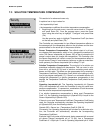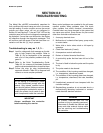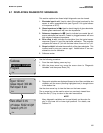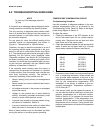
56
MODEL 54e pH/ORP SECTION 7.0
SPECIAL PROCEDURES AND FEATURES
7.3 SOLUTION TEMPERATURE COMPENSATION
This section is for advanced users only.
It explains how to input values for:
• the isopotential pH and
• the temperature coefficient for solution temperature compensation.
1. Beginning from the main menu, move the cursor down to "Program"
and press Enter (F4). From the program menu, move the cursor
down using the arrow key to highlight "Configure" and press Enter
(F4).
Use the arrow key again to highlight "Temperature Coeff" (as shown
on the left) and press Enter (F4) .
The Controller can compensate for two different temperature effects on
the measured pH: the temperature effect on the pH sensor and the tem-
perature effect on the actual pH of the process solution.
Sensor Temperature Compensation. The millivolt output of a pH sen-
sor changes with temperature, which in turn, changes the measured pH
value. The Sensor Isopotential pH (Sensor ISO) is the pH where the pH
sensor's output does not change with temperature. The Controller uses
the Sensor Isopotential pH value to correct for the temperature effect on
the pH sensor. Except in rare instances (antimony or glass on metal elec-
trode systems), the Sensor Isopotential pH is always 7.0 pH.
Solution Temperature Compensation. The actual pH of a solution can
sometimes noticeably change with temperature. This can occur in solu-
tions with a pH above 6.5 pH and in solutions containing weak acids,
bases, and their salts. This effect can be compensated for by entering a
Temperature Coefficient (Temperature Coeff) which is the change in solu-
tion pH per degree centigrade (°C). If there is no noticeable solution pH
change with temperature, or solution temperature compensation is not
desired, the Temperature Coefficient (Temperature Coeff) should be set
to 0.00.
Operating Isopotential pH. The Operating Isopotential pH (Operate
ISO) is the Isopotential pH, which the Controller is using for overall tem-
perature compensation. It represents a combination of both the sensor
and the solution temperature compensations.
If no solution temperature compensation is being used (Temperature
Coeff = 0), the Operating Isopotential pH (Operate ISO) is equal to the
Sensor Isopotential pH (Sensor ISO).
If there is a non-zero Temperature Coefficient (Temperature Coeff) being
used, the Controller automatically calculates the Operating Isopotential
pH (Operate ISO) from the following relation:
Operate ISO = Sensor Iso - (Temperature Coeff) X (298.16)
Conversely, if an Operating Isopotential pH is known for a particular solu-
tion, the Controller will automatically calculate the corresponding
Temperature Coefficient.
Example: High Purity water with Ammonia, being measured with a normal
pH sensor (Sensor Isopotential pH of 7.0 pH), has a Temperature
Coefficient of -.033pH per °C and an Operating Isopotential pH of 16.84.
Temp coeff: +.000
Operate iso: +07.00 pH
Sensor iso: 07.00 pH
Exit Edit
Security
Temperature Coeff
Temperature sensor
Exit Enter







